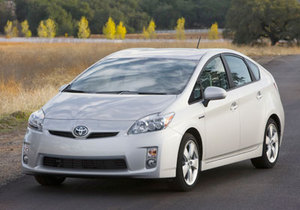2010 Toyota Prius Review: Engine, Performance, MPG, Styling, and Pricing
The 2010 Toyota Prius has been redesigned top to bottom, with more family
space inside and more Lexus-style luxury technology. We can expect this
next evolution of America’s best selling hybrid car to be roomier,
faster and more fuel-efficient than the current model.
At first glance, the 2010 Prius may not look like an all-new car,
meaning a ground-up redesign and a complete re-engineering. The 2010
Prius is nearly identical in shape to the current version, with a wedge
nose, arcing roof and sheer, flat rear end. Yet close inspection
reveals that the highest point in its curved roof has moved rearward,
somewhere over the rear seat. The grille-and-headlight design is much
less bland, and lenses over the LED taillights are white.
We think the new Prius is more handsome, more stylish, than its
predecessor, and the changes have further improved its aerodynamics.
Toyota reports a remarkable, wind-cheating drag coefficient of just
0.25 Cd.
The new 2010 Toyota Prius looks a lot like the new 2010 Honda Insight,
another hybrid-powered, five-passenger car with which it will compete.
Engineers have minimized weight gain in the Prius by forming its hood,
rear hatch and many suspension components from lightweight aluminum.
The new car has the same wheelbase as the old car, and length and width
have increased only a fraction of an inch. Yet passenger space
increases five cubic feet, and the Prius is classified by the federal
government as a mid-size car, the same class that includes the larger
Toyota Camry sedan.
Contrary to conventional wisdom about smaller engines saving fuel,
Toyota has given the new Prius a larger gasoline engine. The
four-cylinder’s displacement increases from 1.5 to 1.8 liters, and peak
horsepower increases by 22 to 98 hp. Factor in the electric motor, and
there’s a total of 134 hp on tap. The larger engine provides
substantially more torque, which means quicker acceleration. Yet,
according to Toyota, the new powertrain delivers better gas mileage on
the highway. The extra torque allows the Prius to maintain freeway
speeds with the engine operating at lower rpm, using less fuel.
Virtually all of the hybrid drive system has been redesigned to reduce
weight. The power inverter, electric motor and continuously variable
automatic transmission (CVT) are 20 percent lighter than before, as a
package.
The new Prius will have disc brakes at all four wheels, rather than
rear drums, and Toyota claims the car is better at capturing energy
lost as it slows, then turning it into electricity stored in the
battery pack.
The 2010 Prius lets its driver choose among three performance modes.
EV-Drive uses only battery power for low speed motoring up to a mile.
Eco mode optimizes fuel economy. Power mode delivers the best
acceleration and the most immediate response when the driver steps on
the gas.
Toyota claims the 2010 Prius will deliver the highest fuel economy
ratings of any car, regardless of size, with a EPA-estimated Combined
City/Highway rating expected to be about 50 mpg.
Inside, the new Prius looks futuristic. A large, center-mounted LED
screen displays virtually all information, including feedback on
powertrain efficiency to help the driver maximize fuel economy. The
cantilevered center console raises the gear selector high above the
floor, and leaves storage space in the pass-through underneath. Some
panels inside are formed from carbon-neutral plastics made from plant
material rather than petroleum.
Toyota promises a smoother, quieter driving experience, thanks to better sound insulation and vibration dampening.
Measured by features and available options, the Prius is moving
upscale. A solar panel moonroof powers a fan that will ventilate the
interior on warm, sunny days. A remote-operated air conditioning system
will also be available, allowing the driver to warm or cool the car on
battery power before anyone gets inside. The new Prius can also be
quipped with Lexus-style features such as LED headlights, radar-guided
cruise control and a self-parking guidance feature.
Passive safety features include a driver’s knee airbag in addition to
the standard complement of front, front-passenger side-impact and
curtain-style head protection airbags. Active headrests, intended to
reduce whiplash injuries in rear impacts, are standard.
Retail prices for the 2010 Prius won’t be set until the car goes on
sale. We predict an increase of 4 percent over the previous model’s
$22,700 base price. Factor in all the trick new options, and a loaded
2010 Prius will easily run into the low- to mid-$30,000 range.
The Prius was a hot seller when gas prices were high in the first half
of 2008, sometimes accounting for a third of all Toyota sales in some
areas, such as San Francisco. Prius sales slipped plummeted when gas
prices dropped. They fell further in the last half of 2008 when the
home mortgage crisis hit. Now many buyers are likely waiting for this
next generation Prius. It’s almost here. And everything about the new
one suggests its leadership among hybrid-powered cars will continue.

